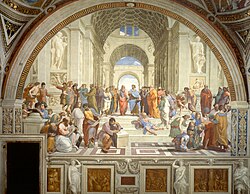Renaissance in Poland
| Renaissance |
|---|
 |
| Aspects |
| Regions |
| History and study |
| Part of a series on the |
| Culture of Poland |
|---|
 |
| Traditions |
|
Mythology |
| Cuisine |
| Festivals |
| Religion |
The Renaissance in Poland (
Overview
The

The Renaissance values of the dignity of man and power of his reason were applauded in Poland.
Young Poles, especially sons of nobility (
Art

Incentives for development of art and
Renaissance painting was introduced in Poland by many immigrant artists, such as

The centre of musical culture was the royal residence at Kraków, where the royal court welcomed many foreign and local performers.
Notable Polish Renaissance artists

Among the most prominent Polish Renaissance writers and artists, whose accomplishments have become a salient part of Polish curriculum are poets
Literature
The first
Literature progressed beyond being dominated by religious themes.
Science and technology
Scientific scholars of the period include
Architectural trends and periods
Polish
First period

In 1499
In the first period of the Polish Renaissance, churches were still build mostly in the Gothic style. In this time, only new chapels surrounding the old churches were sometimes built in the new style. The most prominent of them, the Sigismund's Chapel at the Wawel Cathedral, was built in 1519–33 by Bartolomeo Berecci.[17]
Second period

The Renaissance style became most common throughout Poland in its second period. In the northern part of the country, especially in Pomerania and in Danzig (Gdańsk), there worked a large group of Dutch-born artists. Renaissance style in other parts of Poland varied under local conditions, producing different substyles in each region. Also, some elements of the new Mannerist style were present. Architecture of this period is divided into three regional substyles: "Italian" – mostly in the southern part of Poland, with the most famous artist there being Santi Gucci, the "Dutch" – mostly in Pomerania, and the "Kalisz–Lublin style" (Polish: styl kalisko-lubelski) (or the "Lublin Renaissance") in central Poland – with most notable examples built in Kalisz, Lublin, and Kazimierz Dolny.[18]
All over Poland, new castles were constructed, bearing the new quadrilateral shape enclosing a courtyard, with four towers at the corners. Prominent examples include: the castle at Płakowice (16th century), the castle at Brzeg, (rebuilt from a Gothic stronghold in 1544–60), the castle at Niepołomice (rebuilt after a fire in 1550–71), the castle at Baranów Sandomierski (built in 1591–1606 by Santi Gucci), and the castle at Krasiczyn.[19]
Many cities erected new buildings in the Renaissance style. New

Examples of Pomeranian Renaissance which developed under the influence of Northern Europe rather than Italy[citation needed] were: Green Gate in Gdańsk (built in 1564–1568 by Hans Kramer), Upland Gate in Gdańsk (finished by Willem van den Blocke in 1588), Great Arsenal in Gdańsk (built in 1602–1606 by Anthonis van Obbergen), and the Old City Hall in Gdańsk (built in 1587–1595, probably by Anthonis van Obbergen).
Characteristic laicization of life during Renaissance and Reformation resulted in only minor development in sacral architecture. Mainly chapels were being built in the Renaissance style, but some churches were also rebuilt including: Cathedral in Płock (rebuilt after fire by architects Bernardino de Gianotis, Cini, Filippo di Fiesole and later again by Giovanni Battista di Quadro); and, the Collegiate in Pułtusk (rebuilt by John Batista of Venice). Only a few new churches were founded, such as the collegiate church of St. Thomas in Zamość.[20]
Third period

A fire at
See also
- Polish Golden Age
- Lublin Renaissance
- Mannerist architecture and sculpture in Poland
- History of Poland (1385–1569)
- Ducal Castle, Szczecin
- Duchy of Pomerania
Notes
- ^ "Montelupi". encyklopedia.interia.pl (in Polish). Retrieved 2010-08-14.
- ^
- ^
- ^ "Mikołaj Rej i Jan Kochanowski - najwybitniejsi przedstawiciele polskiego odrodzenia". Retrieved 21 May 2020.
- ISBN 0-415-09279-5.
- ISBN 0-521-47799-9.
- ISBN 0-8020-3711-9.
- ISBN 1-56324-575-2.
- ^ Gerhard Rempel. "The Tartar yoke". mars.wnec.edu. Archived from the original on 2007-09-30. Retrieved 2010-08-14.
- ISBN 978-3-540-72129-1.
- ^ The much admired Sigismund Chapel, called "the pearl of the Renaissance north of the Alps" by foreign scholars.Joseph Slabey Rouček (1949). Slavonic encyclopaedia. Philosophical Library. p. 24.
- ISBN 0801422868. Retrieved 21 May 2020.
- ISBN 978-9004226470. Retrieved 21 May 2020.
- ISBN 9781524596644. Retrieved 21 May 2020.
- ^ Harald Busch, Bernd Lohse, Hans Weigert, Baukunst der Renaissance in Europa. Von Spätgotik bis zum Manierismus, Frankfurt af Main, 1960
Wilfried Koch, Style w architekturze, Warsaw 1996
Tadeusz Broniewski, Historia architektury dla wszystkich Wydawnictwo Ossolineum, 1990
Mieczysław Gębarowicz, Studia nad dziejami kultury artystycznej późnego renesansu w Polsce, Toruń 1962 - ^ "PIESKOWA SKAŁA – CASTLE". Retrieved 21 May 2020.
- ISBN 9780741417572. Retrieved 21 May 2020.
- ^ "Odkrywamy Lublin: Szlakiem renesansu". Retrieved 21 May 2020.
- ^ "KRASICZYN – THE CASTLE AND PARK COMPLEX". Retrieved 21 May 2020.
- ^ "THE COMPLEX OF THE COLLEGIATE CHURCH (CURRENTLY HAVING THE STATUS OF A CATHEDRAL) OF THE RESURRECTION OF OUR LORD AND OF ST THOMAS THE APOSTLE". Retrieved 21 May 2020.
- ^ "Lubelskie". Retrieved 21 May 2020.
